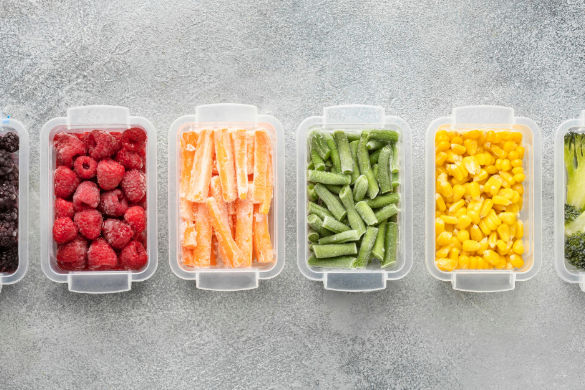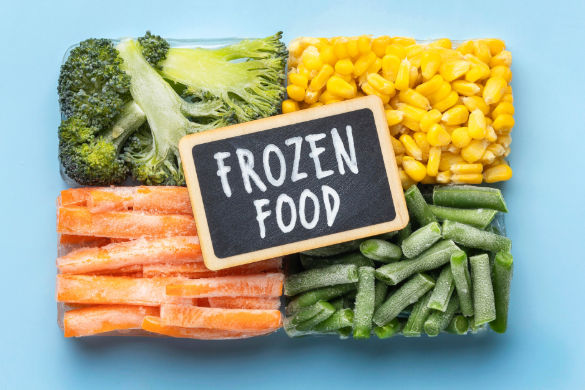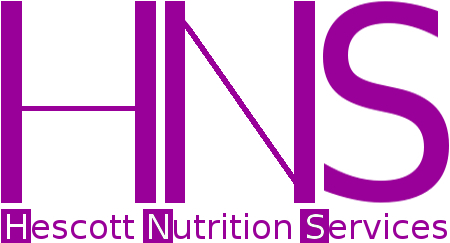.
Welcome to my blog!
.
Frozen to Fabulous: Elevating Everyday Meals with Ease
By Hescott Nutrition Services | posted in February 2025 | Frozen Foods, Fresh vs Frozen, Freezer Staples, Cooking with Frozen Ingredients, Freezing and Storing.
Have you ever wondered about the journey of your favorite frozen peas or that handy bag of mixed berries? Frozen foods have come a long way, and with a little creativity, they can transform any meal from mundane to marvelous. Let's dive into the fascinating world of frozen foods and discover how to make the most of your freezer stash.
A Brief History of Frozen Foods

The brand name synonymous with many frozen foods in supermarkets, Birdseye, originates from Clarence Birdseye, who revolutionized food freezing. In 1924, he developed a quick-freezing method that preserved food's color, nutrients, and texture. Inspired by the Inuit people's practice of rapidly freezing freshly caught fish in extreme cold, Birdseye's method was a game-changer compared to the slow-freeze techniques of the time, which caused large ice crystals to form and degrade food quality. His innovation led to 168 patents, encompassing not just the freezing process but also the packaging materials and printing techniques.
Fresh vs. Frozen: Nutrition Showdown

Frozen fruits and vegetables start just like their fresh counterparts. However, fresh produce is often harvested before peak ripeness to allow ripening time during transportation to the store. In contrast, produce destined for freezing is picked at peak ripeness, then washed, sometimes blanched (as with tougher vegetables like broccoli), and flash-frozen. This process halts enzyme activity that would otherwise cause spoilage. While frozen fruits and vegetables may have a slightly softer texture when thawed, they retain the same nutrient content as fresh produce and offer a convenient way to enjoy delicious, high-quality fruits and vegetables year-round.
The Versatility of Freezer Staples
Your freezer can be a treasure trove of ingredients waiting to be turned into delicious dishes. Stock up on essentials like chopped onions, spinach, broccoli florets, and a variety of fruits. Don't forget proteins such as chicken, shrimp, and fish. These staples are perfect for quick meals without compromising flavor and nutrition.
Creative Cooking with Frozen Ingredients
Ready to unleash your culinary creativity? Here are a few ideas to get you started:
- Ginger Garlic Shrimp and Broccoli: A quick stir-fry using frozen shrimp and broccoli, seasoned with ginger and garlic, can be a delightful weeknight dinner.
- Chicken Gumbo: Combine frozen chicken and vegetables with spices for a warming gumbo that feels like a hug in a bowl.
- Turkey Cauliflower Street Taco Bowl: Use frozen cauliflower rice and ground turkey to create a nutritious and satisfying taco bowl.
Best Practices for Freezing and Storing

To make the most of your freezer:
- Vacuum sealing: This helps lock in freshness and prevent freezer burn.
- Use glass jars: Perfect for freezing liquids, but remember to leave space for expansion.
- Flash freeze: Spread items on a baking sheet before bagging to prevent clumping.
- You can freeze items you won't typically find in the grocery store.
- Scallions, good for 18 months
- Fresh herbs, good for 12 months
- Cooked grains and beans, good for 6 months
- Homemade stock (water + veggie scraps + aromatics), good for 2-3 months
- Homemade sauces (great way to utilize basil, parsley, or cilantro that is starting to turn), good for 2-3 months○ Homemade soups (made from other freezer staples), good for 2-3 months
- Bread (ends of loaves, stale pieces, etc.- great for breadcrumbs or bread pudding), 3 months
- Roasted vegetables, good for 3 months
- Raw vegetables, good for 6 months
- Fruits (make sure to peel apples, bananas, etc. before freezing), good for 6 months
Conclusion
With some planning and a well-stocked freezer, you can easily create healthy and delicious meals. So next time you're at the store, embrace the frozen aisle and let your creativity flow in the kitchen!
For more tips and recipes, sign up for our mailing list to stay connected by going to the page,
or call 347-915-3738.
